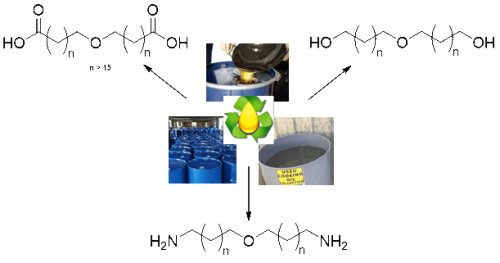Tailored monomers
iPRACS invented new methods for producing long-chain bifunctional (or multi-functional) molecules, predominantly based on fatty acids (obtained from wasted cooking oil or inedible vegetable oils). This led to patented [1] technology to make long α-ω di-functional linear molecules with symmetrically placed ether bond (Fig. 1) as building blocks closing the gap between small molecules and polymers, or in a polycondensated form, in the production of oligomers and/or polymers, surfactants, lubricants, coatings, colloidal stabilizing surface chains/molecules.
The demand of α,ω-bifunctionalized molecules is high as they found an application in the synthesis of different type of polymers. The biggest problem with such molecules is that they are not naturally occurring. A lot of synthetic approaches were taken to synthesize these compounds but they required harmful condition with negative environmental impact as well. The more sustainable methods allow obtaining α,ω-bifunctional compounds but only with short carbon chain (e.g. lactic acid) leading to limited diversity of properties.
The goal of this project was to realize a sustainable method for the preparation of long carbon chain α,ω-bifunctionalized molecules starting from unsaturated long chain fatty acids and/or their derivatives with tunable design properties. The method of production is green and allows to realize in a flexible way different chain length. Properties of these materials are at this moment benchmarked to related commercial available (if present) monomers, the latter having high market prices. The products have high stability, also oxidative, thus overcoming for example the instability of unsaturated compounds. These long-chain monomers can be used to make tailored materials with unique properties; combining hydrofobicity with a condensation production method, or an alcoholysis based recovery method. The monomers can be either used in standalone applications, as additives or oligomeric tensides, or can be used in tailored (block co-)polymers. The latter may be biodegradable, depending on the exact formulations used.
Currently we are further studying and improving the catalytic reactions for the production of these monomers, and developing several applications in e.g. degradable coatings and polymers.
[1] Pazdur Lukasz, Tavernier Serge M F; Long Alpha-Omega Di-Functional Linear Ethers; WO2019175352 (A1); 2019
